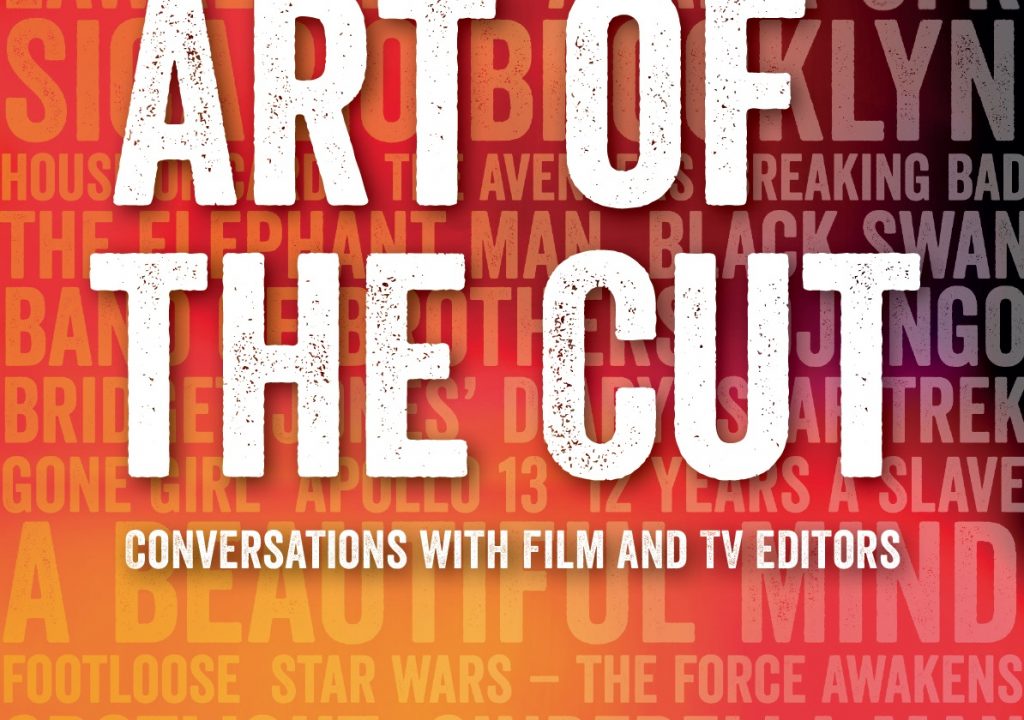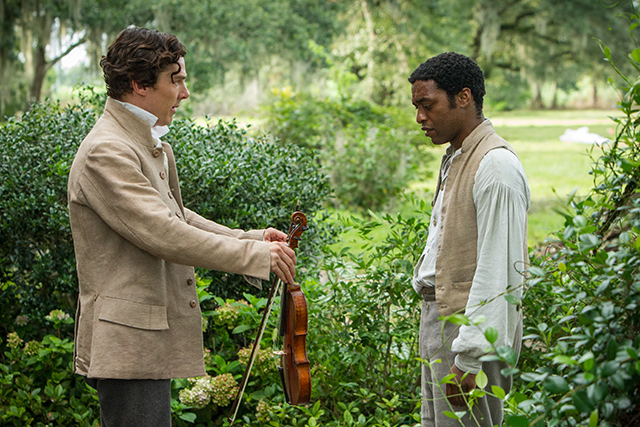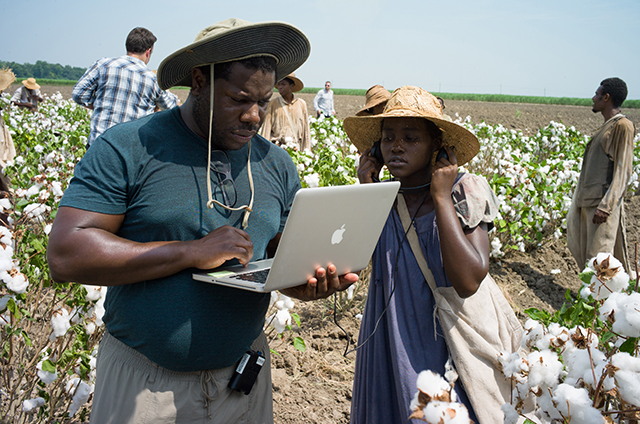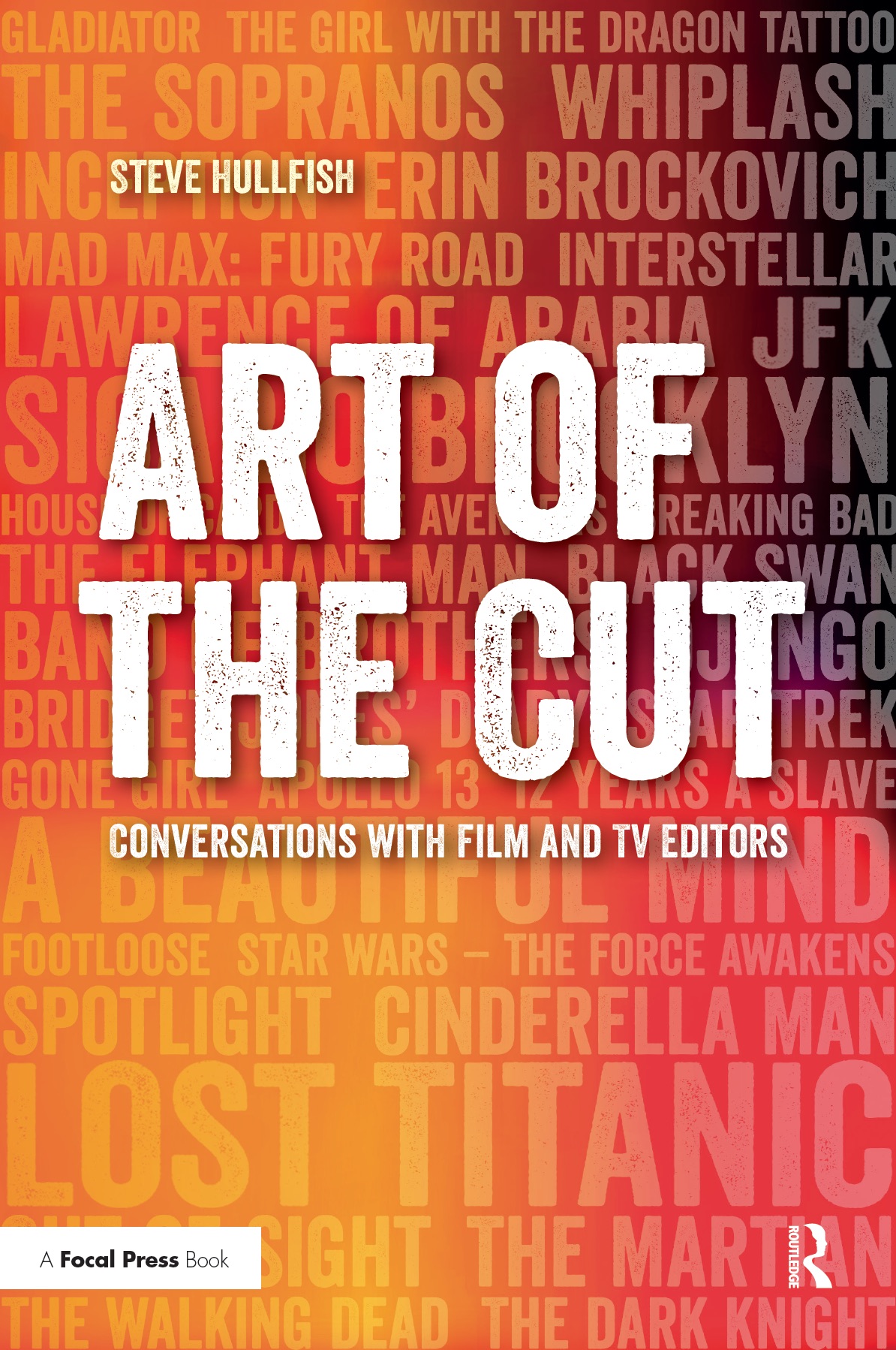 It’s not often that Hollywood’s stars publicly recognize the great stewardship that an editor of a film has of their performance. But it’s a long journey between what an actor emotes in front of a camera and the reception of that performance by an audience. The director certainly has a strong influence on that performance, but the editor (with the director’s guidance) is the final gatekeeper of the performance the audience sees and the context in which it’s seen.
It’s not often that Hollywood’s stars publicly recognize the great stewardship that an editor of a film has of their performance. But it’s a long journey between what an actor emotes in front of a camera and the reception of that performance by an audience. The director certainly has a strong influence on that performance, but the editor (with the director’s guidance) is the final gatekeeper of the performance the audience sees and the context in which it’s seen.
As I watched the Academy Awards I was stunned to hear Lupita’s Nyong’o’s emotional award speech after winning Best Supporting Actress for her portrayal of Patsey in “12 Years a Slave.” Many people focused on her great message encouraging “the validity of your dreams.” But I was struck by a brief, but heart-felt acknowledgment of “the invisible performer in the editing room, Joe Walker.” My first thought was, “There’s one smart actress.” My second thought was that I wanted to talk to the editor whose talents were so obvious to an actress that he was worth acknowledging as a fellow “performer.”
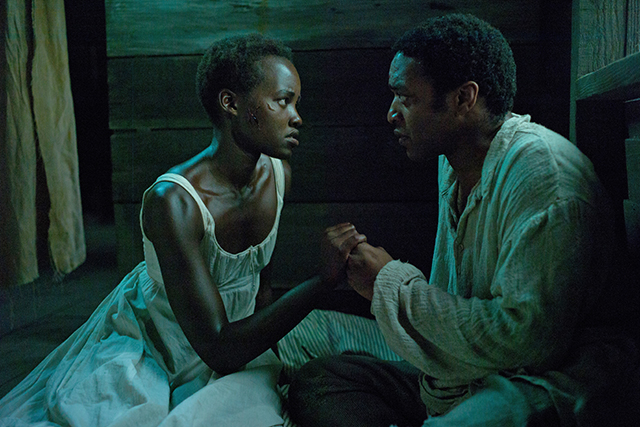
Lupita Nyong’o as “Patsey” and Chiwetel Ejiofor as “Solomon Northup” in 12 YEARS A SLAVE.
Luckily for me, that man – Joe Walker – speaks eloquently about his art and is generous in sharing his time and wisdom. I Skyped with him on a Sunday morning. Walker is a new British transplant to L.A. He began our conversation by saying he was recovering from a late Saturday night review session on his upcoming project with Michael Mann; an as-yet-unnamed project known by the artless acronym: “UMP,” standing for “Untitled Mann Project.”
My curiosity about how an editor evoked a personal “thank you” from an actress during the Oscars, started our interview.
WALKER: She’s amazing. I can’t express how grateful I am to her. You work day in and day out with actors’ performances and it’s a position of trust. But also, when you cut something like a swordfight or a fistfight, you end up with aching muscles at the end of the day because you can’t help but empathize and experience their feelings and react with them. So I do feel like I’m in a kind of dance with the actors.
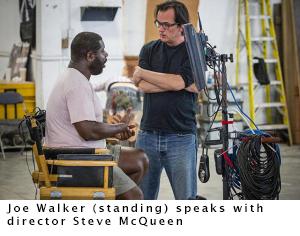 Lupita is so smart. She’s an amazing find and a huge star. Very early on, Tessa Ross from Film Four said, “She’s going to win an Oscar, this girl.” Lupita’s very fast on her feet. She researched her character very carefully, and that led to an improvised scene that really sold me on her straightaway. There was an early moment during the shoot when both Steve and I felt we needed to set up the triangle between Epps, Epps’ wife and Patsey better than was planned. As part of her research for the role, Lupita had taught herself how to make these corn dolls and that led to that mesmerising sequence where she’s sitting in a field making a little toy family, then we used a shot from somewhere else of Mistress Epps looking out from the balcony and stepping away – and within seconds we’ve established the crazy dynamics of this household that Solomon has stepped into, without a single word being spoken. To me there’s something very telling about these corn dolls. Patsey’s a simple person. There’s a naïve feeling about her, like any young girl playing with dolls which stands in contrast to the harshness of what the household has in mind for her. And there’s something darkly ironic about the way she’s dressed in these grubby hand-me-downs, in a style 20 years behind the times, like an anachronistic figure in the doll house herself. It’s such a winning little scene and yet it was done so simply : it’s only two shots against just a patch of grass. That’s where Lupita’s research paid off, and she just nailed the character in a magical way. That critical scene was, like many in Steve’s films, a spontaneous thought: a moment of play that pays off.
Lupita is so smart. She’s an amazing find and a huge star. Very early on, Tessa Ross from Film Four said, “She’s going to win an Oscar, this girl.” Lupita’s very fast on her feet. She researched her character very carefully, and that led to an improvised scene that really sold me on her straightaway. There was an early moment during the shoot when both Steve and I felt we needed to set up the triangle between Epps, Epps’ wife and Patsey better than was planned. As part of her research for the role, Lupita had taught herself how to make these corn dolls and that led to that mesmerising sequence where she’s sitting in a field making a little toy family, then we used a shot from somewhere else of Mistress Epps looking out from the balcony and stepping away – and within seconds we’ve established the crazy dynamics of this household that Solomon has stepped into, without a single word being spoken. To me there’s something very telling about these corn dolls. Patsey’s a simple person. There’s a naïve feeling about her, like any young girl playing with dolls which stands in contrast to the harshness of what the household has in mind for her. And there’s something darkly ironic about the way she’s dressed in these grubby hand-me-downs, in a style 20 years behind the times, like an anachronistic figure in the doll house herself. It’s such a winning little scene and yet it was done so simply : it’s only two shots against just a patch of grass. That’s where Lupita’s research paid off, and she just nailed the character in a magical way. That critical scene was, like many in Steve’s films, a spontaneous thought: a moment of play that pays off.
HULLFISH: For me that scene also gave me a sense of Patsey’s humanity. That she was a real person, human, and more than the cotton picking machine that Epps saw her as.
WALKER: Exactly. I wish I’d said that!
HULLFISH: This is your third collaboration with Steve McQueen. How did that partnership get started?
WALKER: I met him in interview for “Hunger.” Prior to “Hunger” he hadn’t made any conventional films. He won the Turner prize as a video artist – that’s the big art prize in London. I hadn’t seen many of his art pieces, but I’d read the script, which was brilliant. Later we discovered we’d grown up in exactly the same part of London, less than a mile away from each other. So there was a lot of common ground. We did “Hunger” and “Shame” and are still together.
HULLFISH: How do you navigate the difference in dealing with directors (McQueen and Mann) who are so different?
WALKER: Well, it sort of adds spice to life. (laughs) Michael was a huge fan of “Shame” which is how I got the job. A lot of directors have a tremendous respect for each other’s work. Having worked on three of Steve’s film, I feel like that our collaboration has become very powerful. I’ll tell you this, I feel like I’m the best editor I can be with Steve. He has that affect on people. He has high expectations, but he also nurtures and creates an atmosphere in which you can do your very best work. Steve and Sean Bobbitt (the DP) have worked together for 13 years and seeing them work together on set is fascinating because a lot is not even verbalized. They’re just playing together. It’s a remarkable symbiosis between a director of photography and a director. One of the great joys of “12 years” was being in Louisiana and watching them work.
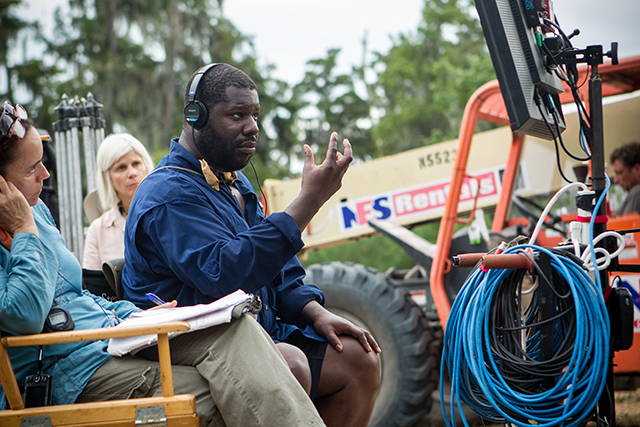
Steve McQueen on the set of 12 YEARS A SLAVE.
HULLFISH: What do you think you bring to McQueen in particular that he has come to rely on you for? Is there a specific aspect of editing – honing the story, or sculpting a performance or serving as a counterbalance to his own ideas – that he appreciates the most?
WALKER: It’s funny. Steve said in an interview that we – that is : Steve, Sean, Michael Fassbender and me– are like The Rolling Stones. We go off and do other gigs and then we get back together. When I heard that, it made me wonder “which one am I? I really want to be Charlie Watts!” But let’s not pursue that one! (laughs)
My background is kind of peculiar because I did the whole assistant editor -dubbing editor – film editor kind of path, originally at the BBC then as a freelancer, but I had a parallel career writing music for a long time. I trained as a classical composer and was drawn pretty early to the sort of avant-garde end of things – the heroic leading lights of the new music of the 60s and 70s. So there’s something we had in common there… there’s a kind of attitude that comes from that background and it’s always going to lead to unconventional, even perverse choices sometimes. The things that excite me about working with Steve’s material – and “12 years” is really a good example of it – is that I love working with performance and music and image and sound and all that, but you also get to work with time. That’s a super-power unique to editing. So there are flashbacks and some sequences or shots in “12 years” that are held for a very long time which allow the audience to kind of invest and really study an image, but you have to balance that with a commercial sense and landscape things so that it doesn’t feel like artistic indulgence, but serves the story.
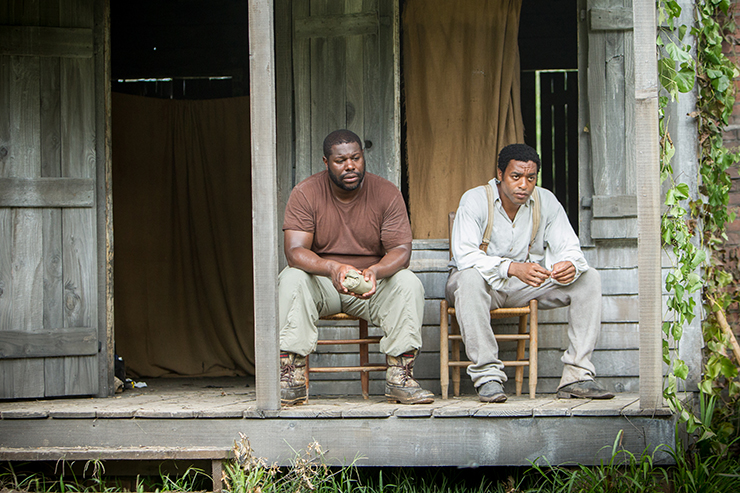
Steve McQueen and Chiwetel Ejiofor on the set of 12 YEARS A SLAVE.
HULLFISH: Give an example of what you mean by working with time. And what do you mean by “landscaping?”
To give you the overview, the original book and the screenplay were chronological. The driving force was the calendar. After filming finished, we worked together for 10 weeks. The exploration began when we realised that this might not be the best way to drive the story. And maybe the better way is through following the expressive inner world of Solomon. That led us down a path of flashbacks. There were a few imperatives that we felt we had to obey. One was that we needed to immerse ourselves in the slave experience at the beginning and that we need him in chains by the end of reel one. And in serving that, it loosened up the timeline so that we could tell some elements of the story in the rear-view mirror. A good example is Eliza who has her children torn away from her. Originally, in the chronological story she told her backstory upon meeting Solomon. They were in a cell together in the slave pen in Washington and she explained how she had been the master’s favorite and borne him a child, but it felt like it was holding up Solomon’s first experiences of captivity so we held it back until after the moment where we actually see her for the last time, being dragged off. Then we played the scene of Solomon remembering this tale that she’d told him and it felt so much more poignant: to go from a woman in incredible distress to the same woman with a broad smile on her face, explaining the fine clothes she used to wear. It’s little experiments like that. The film originally started with Solomon stringing then playing the violin, going shopping with his wife, his wife leaving and meeting two people in Saratoga, traveling to Washington and then waking up in chains. That’s how the story used to start.
The thing I mean about landscaping, is if you take a scene like the hanging scene, Steve had made a choice. He loved that scene in the book and could see it immediately. One of the ideas he’d sculpted into it was that when he and Sean (Bobbitt, the DP) had been working in the deepest gold mine in South Africa for an art piece called “Western Deep” (2002) he’d noticed that the workers tended not to make eye contact with them. To anyone who was in authority, there was no challenging gaze, they moved as ghosts around them. So you have Solomon left hanging because he’s caught between two masters. One person can’t hang him and the other person can’t cut him down – a casual nightmare taking place within beautiful countryside. That was Steve’s idea of what he wanted as the centerpiece of the sequence. But, if everything is slow up to that point, or after it, it would just feel like artistic indulgence. So what I mean by landscaping is we compress time enormously before it. You see Solomon waiting for the horsemen to arrive, but you don’t see them fully arrive, you don’t see them bind his hands and feet – all this was shot, but not used. When he’s strung up, it’s all happening way too quickly. It’s all racing and we’re sort of ahead of the audience. Then the music stops and we stand back, we’re on a wide shot and we let it breathe. Then after the event we’re also compressing time, so that when the Benedict Cumberbatch character – Master Ford – arrives and cuts him down, he hacks into the rope and we don’t even see Solomon falling to the ground, it just cuts straight into another shot where time’s moved on and he’s lying on the floor of an opulent hallway. You kind of manipulate time so you’re a little ahead of the audience and then you can stop, slow down and use as a soundtrack the rise and fall of the cicadas. We hold that shot for an agonizing time so that hopefully it provokes a response from the audience… that they are witnessing something real, disturbing, and hopefully it makes you just want to stand up and intervene.
There’s a strange trick, that if you put a border around things, without the intervention of cutting, or the intervention of music, then you’re sort of conning the audience into thinking they’re watching something real. There’s no safety net. It’s a little bit like what you might experience in an art gallery. You’re presented with something with a border around it, a frame and you’re initially attached to it, then you detach, then there’s another wave of interest where you’re more glued. That’s something we discovered on “Hunger” where we used a seventeen and a half minute long wide shot of just two people talking. And that too was very landscaped because we’d avoided dialog in the first third of the movie completely. It’s just a visual and sensory increase in violence between two sides in a prison and then you’re really ready for someone to talk about the issues. We studied the audience’s reaction to that scene, which is that they do detach, but then they come back even more invested and even more curious. There’s an incredible tension to it, by not cutting.
Part of the necessary process of film-making, it seems to me, is that you love everything into existence during the shoot while you’re gathering the elements of the film. But in the first assembly of the film, every actor’s poignant pause has been lovingly preserved, and you realize that it’s now dying on its feet. Then you have to twist your logic around to a much more punitive attitude of giving every moment a very tough look. All those pauses, you now have to sell some to buy others. Gradually, hopefully, you get to a place where you don’t want to change anything any more and it’s become solid in some way. I think Scorsese got it right when he said, “Your film is never as great as your dailies and never as terrible as your first assembly.” It feels like you need that process.
Benedict Cumberbatch as “William Ford” and Chiwetel Ejiofor as “Solomon Northup” in 12 YEARS A SLAVE.
HULLFISH: Do you recall the original length of your first cut of the film?
WALKER: It wasn’t very much over… it was 15 or 20 minutes over what we wanted it to be. It was more to do with feeling like you’re watching a boxing match and none of the punches are landing and fists are just flailing around. But we could see the amazing potential.
HULLFISH: You talked about letting things breathe. That’s a great lesson. If anything, as an editor, I tend to err on the side of cutting things too tight. And while I was doing interviews for my book (“Avid Uncut,” coming in May on Focal Press), one of the editors said, “When you cut too tight, you’re not left with art, you’re just left with information.” I thought that was a great quote and I can clearly see that thought played out in your editing on “12 years.” Like the hanging scene. You could have easily cut that scene in half and still gotten the information, but you would have lost the art and the emotion and impact.
WALKER: It’s a careful balance there. It helps in Steve’s films – and it’s probably the reason I say that he allows me to be the best editor I can be – that there’s a fundamental tension to the things he’s depicting. You know violence is just around the corner. He shoots things incredibly economically and for the most part designs things to hold off from cutting. It’s a carefully managed balance between giving enough space to invest in the characters and maintaining the story tension. A really good example of that is at the end of the film, I think it’s the third from the last scene… is just a shot of Solomon looking off into space. It’s just a medium shot and there’s no music. It’s at the end of the film and we know that everybody has a sense that the film is coming to a conclusion and we all have to obey that kind of imperative – from watching 10,000 films – to pace up a little bit at the end and yet, here we are going in the opposite direction. I think we hold that shot of Solomon’s face for ninety seconds. There’re no words. There’s nothing. It’s kind of perverse. But it’s so beautiful. It brings me back to my saying that the best way to explore this story is through the expressiveness of the central character rather than the calendar. We can tell how much time has passed, not through little subtitles saying “1852” but through Solomon’s marvelous face and the toll all that hard labor has taken on him. Those moments are marked by things like Solomon singing along to a spiritual, or the moment when he breaks his violin or the moment I’m now describing where he stares into space and all seems lost.
WALKER: It’s a selection process whereby you keep the drive not only in terms of time but also in terms of visual information. Where possible you try to make a different composition tell its individual story at the right time. If you take the kind of classic coverage of a TV movie: the establishing wide, a two-shot and two singles We all know that managing your ingredients to keep it visually stimulating and keep it driving is really key. You don’t necessarily have to use that establishing wide shot at the beginning of the sequence. There might be a great dramatic way of using it much later. And where possible avoid repeating that shot. That’s a delicate operation that takes place over the course of the whole movie. And how you “play” that scene changes through time as you see the context. Also, if you don’t cut, when you do cut it delivers you such a rhythmic weapon in terms of editing. Although when you hold for seventeen and a half minutes, like that dialog scene in “Hunger,” you better make sure that the first cut after that is exactly in the right place (laughs), ‘cause it’s going to be felt very, very dramatically. The cuts seem to have much more sharp edges than they do in a normal film.
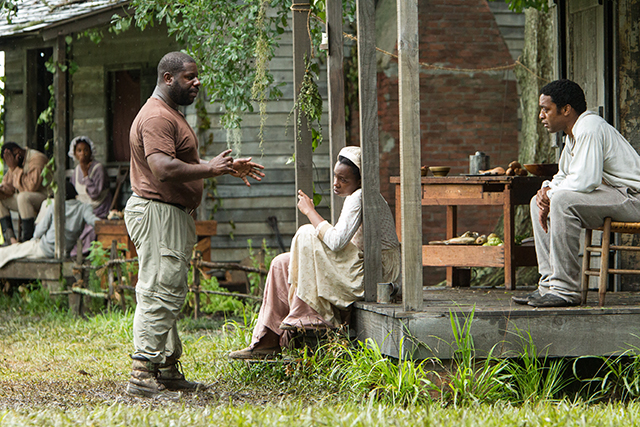
Steve McQueen and Chiwetel Ejiofor on the set of 12 YEARS A SLAVE.
HULLFISH: What did you cut on?
WALKER: I came up probably like yourself, cutting on sprockets, then to Lightworks and then to Avid. I made the change to Avid in the late ‘90s. ‘Twelve Years’ was a very simple set-up. It was just me and one assistant and a post production P.A. So it was a very small team.
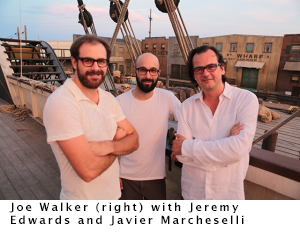 Javier, my assistant uses Nuke quite extensively and he has a lot of expertise in VFX and worked on “Hugo.” He did lots of little fixes and tried little experiments and so on. I also like to use an amazing program that I absolutely adore called Metasynth (http://www.uisoftware.com/MetaSynth/index.php). It’s a little bit techy to use, but when you start pressing buttons you see what it does. It was originally for artists to convert pictures into sound. It would analyze a picture and present it back as a sound. It has one button on it which I completely love called Grain. Pete Tong, a very successful DJ in London showed it to me and explained that when you pull the lever on it you can run a piece of music into it and it freezes the sound. It loops the grain. This fixes the problem that if you’re using temp music and you want to hold on a chord, but the chord moves on too quickly, you’re forced to either cut it off and endure this horrible interrupted chord, or use a reverb. So, much better, you use MetaSynth to take that chord and even if it’s only two seconds long, you can generate a 25 second long extension and fade it out very naturally. So it feels like you’ve composed a last chord.
Javier, my assistant uses Nuke quite extensively and he has a lot of expertise in VFX and worked on “Hugo.” He did lots of little fixes and tried little experiments and so on. I also like to use an amazing program that I absolutely adore called Metasynth (http://www.uisoftware.com/MetaSynth/index.php). It’s a little bit techy to use, but when you start pressing buttons you see what it does. It was originally for artists to convert pictures into sound. It would analyze a picture and present it back as a sound. It has one button on it which I completely love called Grain. Pete Tong, a very successful DJ in London showed it to me and explained that when you pull the lever on it you can run a piece of music into it and it freezes the sound. It loops the grain. This fixes the problem that if you’re using temp music and you want to hold on a chord, but the chord moves on too quickly, you’re forced to either cut it off and endure this horrible interrupted chord, or use a reverb. So, much better, you use MetaSynth to take that chord and even if it’s only two seconds long, you can generate a 25 second long extension and fade it out very naturally. So it feels like you’ve composed a last chord.
HULLFISH: What habits or skills or workflows do you find you’ve carried with your on your journey from your days editing TV for the BBC?
WALKER: I had a really inspirational mentor called Ardan Fisher and he developed my appreciation and appetite for editing. In my twenties and thirties I was very unsure if I should carry on composing or carry on editing. I loved them both but I couldn’t do both. One of the great things about the BBC was that because you were staff, you could vary your diet of what you cut and a lot of the editors would flip between drama and documentaries. In Ardan’s case, he’d go between these very classy and experimental arts documentaries and drama (he cut the seminal series “Edge of Darkness”) and each would inform the other. He edited a great documentary on Orson Welles that I think is one of the best. (“With Orson Welles: Stories from a Life in Film” directed by Leslie Megahey, 1990).
A lesson I really learned from him was about not cutting. It’s not like I apply this rule to everything, Steve, like yourself, I’m sure certain things apply to certain projects and you can’t use the same schtick all the time, but in his case a lesson I really learned was that he let me cut a sequence and it would be a three-shot and then singles and I’d merrily get stuck in the singles. He’d look at it and say, “You’re not getting any more from the singles than you are from keeping it as a three-shot, and with the three-shot you see all of the reactions. And I’d look at the three-shot and see that he was right. It was a great performance… an ensemble performance. The attitude was “Just because they shot it doesn’t mean you HAVE to use it’. That was a real lesson for me.
Steve McQueen and Lupita Nyong’o on the set of 12 YEARS A SLAVE.
HULLFISH: I saw that you are a classical composer whose music has been performed by the Royal Philharmonic Orchestra. It’s my experience that most editors have a musical background. Is there something from your musical training that informs your editing? So many editors are musicians. I have that background as do so many editors I know.
WALKER: We should form a band. We could probably fill out the Royal Albert Hall! It’s a very similar job, don’t you think, Steve? Composing a piece of music is so similar in terms of joining small fragments together and making them all line up “magnetic North.” The best cinema in my view is that which takes into account a musical feel and structure and aligns it to performance and story. You have to be alive to the rhythm of things not necessarily just the rhythm of film scoring. My friend Matthew Herbert said to me, “Music is in an abusive relationship with film.”
HULLFISH: Great quote. What’s your attitude about the temp music that we’re all forced to edit with when constructing a film before the real music is composed?
WALKER: There’s a danger to temp music, but you have to deal with it to survive the screening process and your producers. But if you do that by just acquiring pieces of music from other films, you run the risk of having a score that doesn’t really add up, and you also might end up with a less than original score from your real composer. So there’s many pitfalls to it.
HULLFISH: What is your process of viewing and reviewing and notating the raw materials that come from dailies? How do you decide where you’re going to start on a scene?
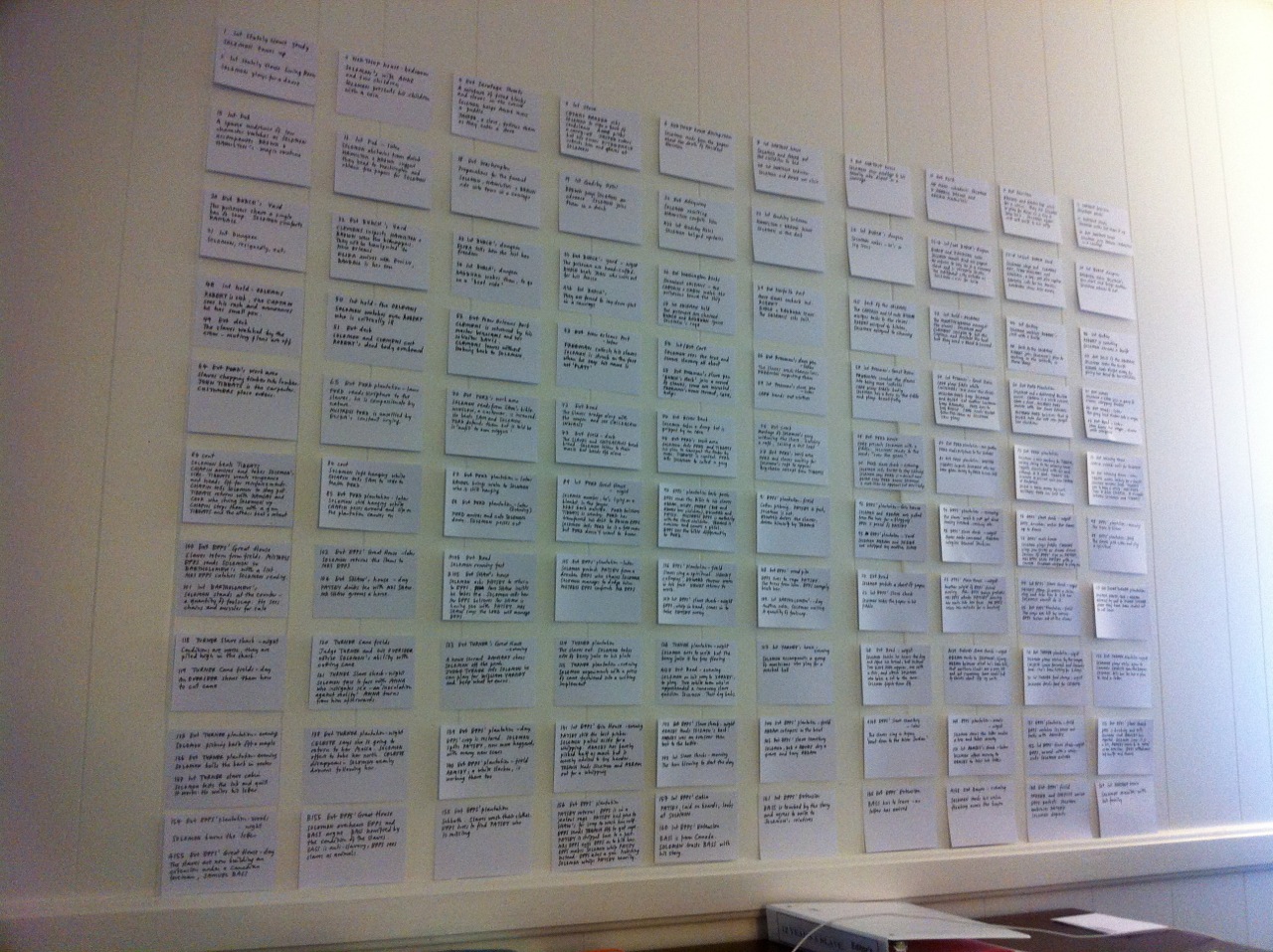 WALKER: I’ve got a very low-fi process. The first thing I do before the shoot starts is to write a very, brief description of each scene on an index card and glue it onto a wall. So I can look and see the scene numbers and a short description. And that stays in the edit room so I can see at a glance where I am in the story. You have to have a superior knowledge of the story to fathom out the continuity but also to know if the beats you need to hit, have been hit. For example, the scene where Solomon is woken by Epps and told to play fiddle – you have to know that the last time we saw him he was whipped, so it would be painful for him to sleep on his back. Luckily with Steve and Sean they don’t overshoot. You’re probably only looking at an hour and a half a day. 35 days for “12 years.” One camera.
WALKER: I’ve got a very low-fi process. The first thing I do before the shoot starts is to write a very, brief description of each scene on an index card and glue it onto a wall. So I can look and see the scene numbers and a short description. And that stays in the edit room so I can see at a glance where I am in the story. You have to have a superior knowledge of the story to fathom out the continuity but also to know if the beats you need to hit, have been hit. For example, the scene where Solomon is woken by Epps and told to play fiddle – you have to know that the last time we saw him he was whipped, so it would be painful for him to sleep on his back. Luckily with Steve and Sean they don’t overshoot. You’re probably only looking at an hour and a half a day. 35 days for “12 years.” One camera.

HULLFISH: One camera. That’s so rare now.
WALKER: Yes. One camera. 35mm film. No second unit. It makes life a lot easier. I’ll watch everything. I’ll remind myself of the script, but as soon as you have dailies it’s no longer a script, it’s living and breathing. The script is the great foundation on which stuff happens. But with Steve’s films, there’s all manner of things that arrive after the script. A really good example is a scene when Epps is waiting in a night shirt when the slaves approach past fields full of cotton. And it was a great scene in the script, but to dress him in night clothes added a kind of sleaziness to him. Then they put a little girl with him and you get the horrible feeling that he’s grooming the next Patsey.
HULLFISH: Do you feel, like I do, that you have to remain a little bit at a distance from the scripted material and the movie production process. That you can’t have too much reverence for the script and what has been shot?
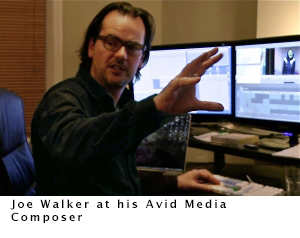 WALKER: I do try to avoid going on set. I feel I have to preserve some distance. Very early in my career I worked on something where I went on location to a large cottage where they were shooting a wedding party and I talked to one of the art directors who’d spent all night decorating the front elevation with $20,000 of flowers. But when it came to cutting, the one thing the director didn’t want was an establishing shot of the house. He wanted to cut straight in to the best man’s speech. I didn’t want to compromise my heart of stone with the knowledge that somebody’s whole night was spent doing something that would never be seen. I also don’t want to be there because I want to respond the same way the audience does. The audience doesn’t get to see what’s around the shot. They only get to see what’s in the shot.
WALKER: I do try to avoid going on set. I feel I have to preserve some distance. Very early in my career I worked on something where I went on location to a large cottage where they were shooting a wedding party and I talked to one of the art directors who’d spent all night decorating the front elevation with $20,000 of flowers. But when it came to cutting, the one thing the director didn’t want was an establishing shot of the house. He wanted to cut straight in to the best man’s speech. I didn’t want to compromise my heart of stone with the knowledge that somebody’s whole night was spent doing something that would never be seen. I also don’t want to be there because I want to respond the same way the audience does. The audience doesn’t get to see what’s around the shot. They only get to see what’s in the shot.
And, I have to acknowledge that editing is only one part of the film, despite my vast egotism, it’s only one part of the process. I was just the beneficiary of the fantastic decision that Steve made at the very inception of the film that if you tell this story from a vantage point of a free man then it offers a unique insight into slavery and one we can all travel along with. You see him as a free man, which is all-embracing.

Filmtools
Filmmakers go-to destination for pre-production, production & post production equipment!
Shop Now